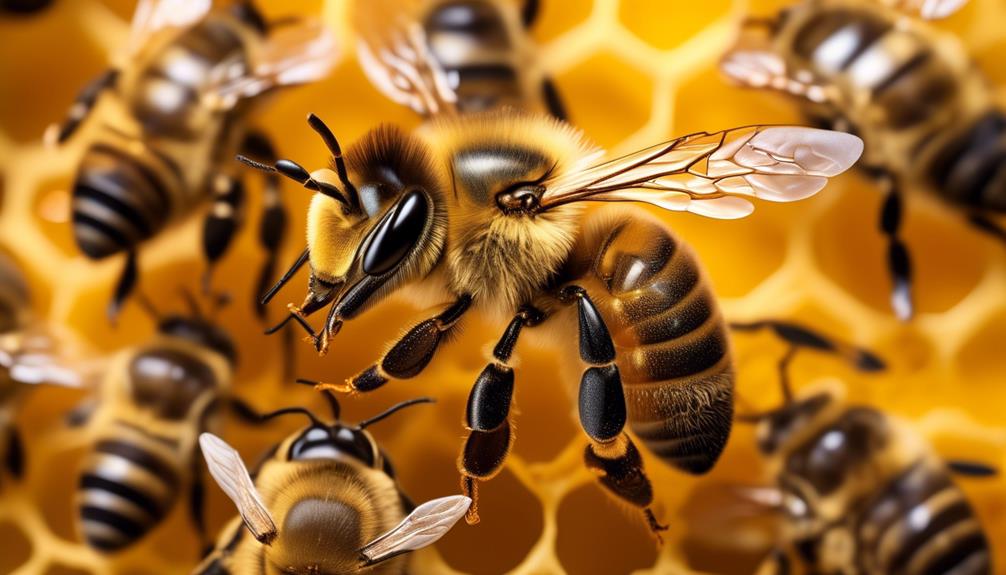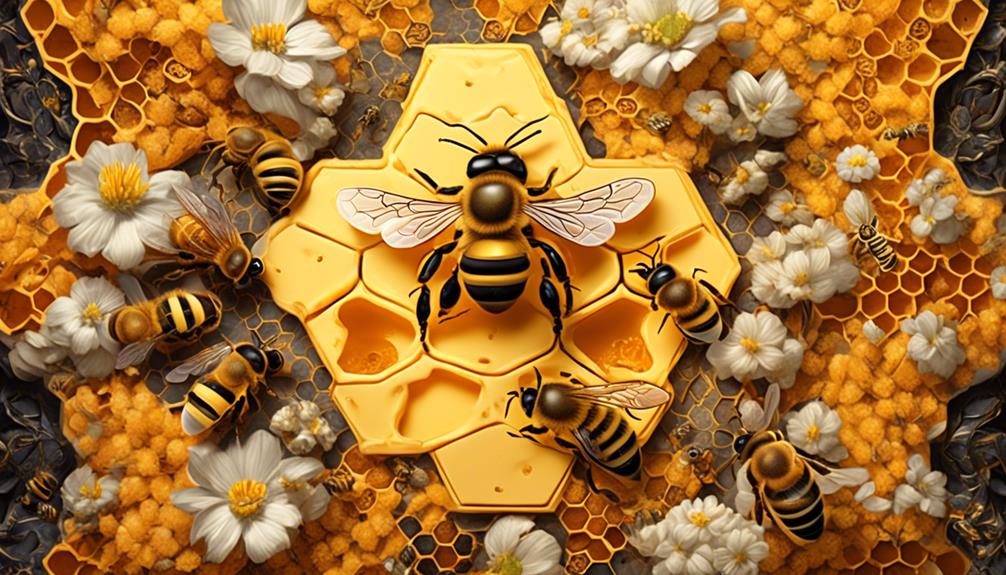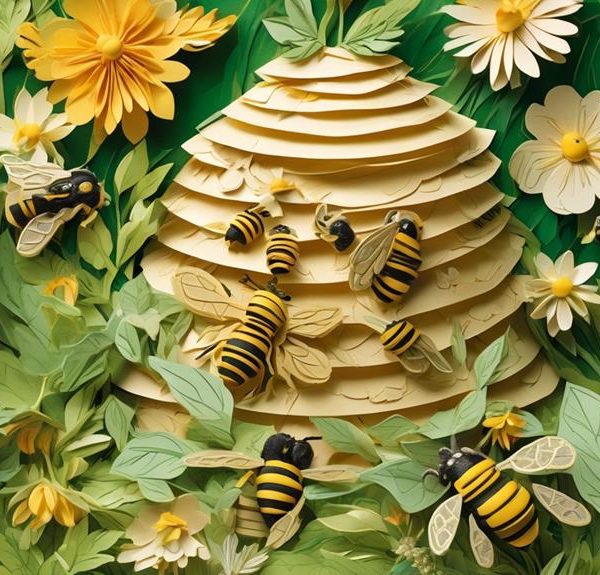Buzz into the captivating world of bee hierarchy and discover the intriguing question: are queen bees born or are they made?

Are Queen Bees Born or Made?
Bustling bees buzz in their hives, but have you ever pondered the process that produces a queen bee? You might assume she's simply born into her royal role, a product of predetermined genetics. Yet, the reality might be more complex.
It's a fascinating field of study, intertwining genetics, environment, and a dash of mystery. However, before we plunge too deep, let's pose the question: Are queen bees born, or are they made?
This intriguing inquiry awaits your exploration.
Key Takeaways
- Queen bees are not born with their royal status, but are selected from worker larvae through the exclusive feeding of royal jelly.
- The queen bee's genetic architecture is primarily determined by her parents' genes, but the ingestion of royal jelly triggers epigenetic processes that activate queen-specific genes.
- Environmental factors such as nutrition, temperature, and hive health can influence the development of queen bees by altering gene expression.
- The transformation of a queen bee involves physical changes, unique behaviors, and the emission of pheromones that regulate the entire colony.
Unveiling the Queen Bee's Origin

Diving into the origins of the queen bee, it's crucial to understand that her royal status isn't a birthright, but rather an outcome of a unique, meticulously orchestrated developmental process. You might've imagined her being born with a golden crown, but in reality, she's selected from the regular worker larvae.
When a colony needs a new queen, worker bees choose a few young larvae and feed them exclusively on royal jelly. This diet, rich in proteins and vitamins, triggers the full development of their reproductive organs, something that doesn't occur in workers who are fed a mixture of pollen and honey.
The transformation isn't just physical. The queen bee also develops unique behaviors. You'll find her laying thousands of eggs daily, while the worker bees can't reproduce. She also emits pheromones that regulate the behavior and physiology of the entire colony.
Understanding Bee Genetics

To truly grasp the queen bee's transformation, it's essential you delve into the world of bee genetics, a fascinating realm where nature's blueprint intertwines with dietary influences to shape her majesty's destiny. The queen bee's genetic architecture is primarily determined by her parents' genes, but the environmental context, particularly her diet, plays a significant role in her development.
In a typical bee colony, the queen bee is the only female who reproduces while worker bees are sterile. The queen's unique reproductive abilities stem from her ingestion of royal jelly as a larva. This diet triggers a cascade of genetic expressions that ultimately result in her becoming a queen.
While all female bees share the same genetic makeup, epigenetic factors, such as DNA methylation, can modify gene expression without changing the DNA sequence. In the case of the queen bee, the royal jelly diet influences these epigenetic processes, leading to the activation of queen-specific genes.
Genetic analysis reveals that these genes are linked to fertility, longevity, and physical size – traits that distinguish the queen from worker bees. Thus, bee genetics provide a compelling explanation for the queen bee's transformation, highlighting the intricate interplay between genetics and nutrition in shaping her destiny.
The Role of Environmental Factors

While genetics play a crucial role in the queen bee's development, it's also vital to consider the environmental factors that contribute significantly towards shaping her destiny. You see, these factors can alter the genes' expression, thereby influencing the bee's development.
For instance, nutrition is a critical environmental determinant. Larvae destined to become queen bees are fed a diet rich in royal jelly, a substance produced by worker bees. This diet facilitates rapid growth and triggers the development of reproductive organs, setting the queen bee apart from her worker counterparts.
Temperature, too, plays a significant role. Queen larvae are typically kept at a slightly higher temperature than worker larvae, and any deviations might negatively impact the queen's development.
Additionally, the hive's overall health and the presence of parasites or diseases can also influence the queen's growth and fitness.
The Transformation Process

Often, you might find it fascinating how a simple larva transforms into a queen bee, a process that's meticulously orchestrated by a combination of genetic and environmental factors. This metamorphosis isn't as simple as it seems. It's a complex interplay of specific conditions and intricate biological processes.
All bee larvae, regardless of their ultimate caste, start life by consuming royal jelly, a protein-rich secretion from the hypopharyngeal glands of worker bees. After the first few days, the diet of future worker bees is switched to honey and pollen, while potential queens continue to dine exclusively on royal jelly. It's this nutrient-dense diet that triggers the transformation.
The royal jelly stimulates growth and development, causing the larva to mature rapidly and reach a large size. It also influences the expression of certain genes, leading to physiological changes such as a fully developed reproductive system, which worker bees lack.
But the process doesn't end here. A potential queen must also survive the pupal stage, a period of intense change where she metamorphoses into her adult form. In essence, the transformation of a queen bee is a result of precise environmental controls, genetic influence, and a dash of survival of the fittest.
Debunking Common Misconceptions

Despite the intricate details of the queen bee's transformation we've just explored, there are several myths and misconceptions that cloud our understanding of this remarkable process. You may have heard the notion that queen bees are born, not made. This is a common misconception. In reality, all bee larvae start with the capacity to become a queen bee. It's their diet, not their genetics, that determines their royal fate.
Another myth is the idea that the queen bee rules the hive. While it's true she's vital for the colony's survival, she doesn't exactly command her subjects. Her role, in fact, is principally reproductive. Worker bees, who are all females, run the hive, make decisions, and even decide when it's time for the queen to be replaced.
Lastly, many believe that the queen bee lives a life of leisure, while the rest of the hive works tirelessly. This couldn't be further from the truth. The queen's job is a demanding one, laying up to 2,000 eggs a day during peak season. So, she's not exactly idling her time away.
Misconceptions aside, the life of a queen bee is a fascinating study in biology and social behavior.
Frequently Asked Questions
What Is the Lifespan of a Queen Bee in Comparison to Worker Bees?
You're wondering about the lifespan of a queen bee versus worker bees.
Well, queen bees typically live for 3-5 years, a stark contrast to worker bees who live just a few weeks!
The queen's longevity is due to her specialized diet of royal jelly, which enhances her endurance.
How Does the Queen Bee Communicate With the Rest of the Bee Colony?
You're wondering how the queen bee communicates with her colony. She does this primarily through pheromones, chemical signals that influence the bees' behavior. Her specific scent informs the workers of her presence and health status.
Moreover, if she's ready to mate or lay eggs, her pheromones relay this too. This silent, scent-based communication keeps the hive functioning smoothly, ensuring the queen's orders are always followed.
It's quite a fascinating system, isn't it?
How Many Eggs Can a Queen Bee Lay in a Day?
You're probably astounded to know that a queen bee can lay up to 1,500 eggs in a single day. She's quite the prolific egg layer, isn't she?
This incredible feat is possible because her body is designed to store millions of sperm, enabling her to fertilize eggs continually. It's nature's way of ensuring the survival and expansion of the colony.
Quite fascinating, don't you agree?
What Happens to the Hive if the Queen Bee Dies Unexpectedly?
If the queen bee dies unexpectedly, it throws the hive into chaos. You'll see the worker bees spring into action, selecting several young larvae to be potential new queens. They're fed royal jelly to encourage their development.
If they don't produce a new queen in time, the hive can collapse. It's a race against time, showing the vital role the queen plays in maintaining the hive's equilibrium.
Are There Any Notable Differences in Behavior Between Queen Bees and Worker Bees?
Yes, there are notable differences between queen bees and worker bees.
As a queen bee, you're responsible for laying all the eggs in the hive. You're also the largest bee with a lifespan of several years.
Worker bees, on the other hand, perform all the other tasks in the hive. They're smaller, and their life span is much shorter. Their duties include foraging for food, cleaning the hive, and taking care of the larvae.
Conclusion
So, you've now discovered that queen bees aren't just born, they're crafted through a complex blend of genetics and environmental factors.
The transformation process, surrounded by misconceptions, is intricate and fascinating. It's a stark reminder of nature's brilliance.
The next time you see a hive, remember, behind its buzzing activity lies a compelling tale of nature's own monarchy, where queens aren't merely born, but meticulously made.



